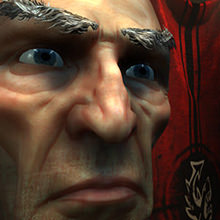post_filter_scattering
This postprocess material allows to create an effect of subsurface scattering. (See how to use postprocess materials).
This material is crucial when rendering human skin. Without it, character face look hard, like dried rubber. Even the highly detailed diffuse, specular, and normal maps used for a character will not make skin look real without subsurface scattering. post_filter_scattering gives the skin realistic reddish color and soft appearance. It simulates the physical process when the incoming light is not only reflected off the skin, but also goes beneath the skin surface, scatters in tissue layers and after that non-absorbed light exits the skin.

|

|
|
|
With subsurface scattering
|
Without subsurface scattering
|
If you are going to use subsurface scattering postprocess, you can increase the detail in the character's diffuse texture and the strength of normals, because they will be blurred and softened.
Parameters
States
| GUI name | XML name | Description |
|---|---|---|
| Mask | mask | Color mask for the materials' auxiliary color. See how to use it as a mask to apply a postprocess only to the selected materials. |



